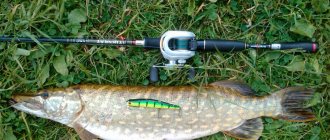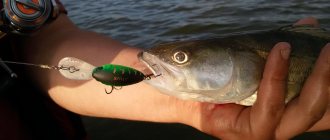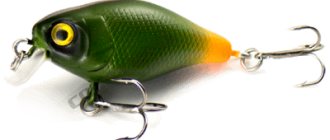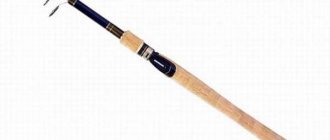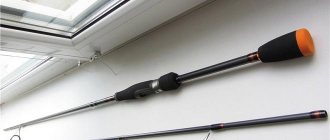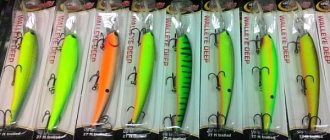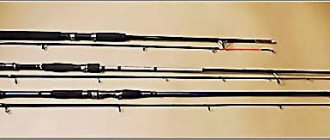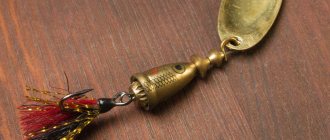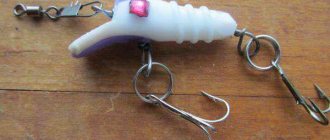Not a single predator can resist artificial live bait, with its bright colors, maneuverable movements and alluring sound.
A competent approach to choosing a wobbler and the correct fishing technique using this highly specialized bait will bring a good catch. This article provides the most detailed overview of the classification and types of this bait, gives the main characteristics and indicates their features, the scope of wobblers, describes wiring and fastening methods, gives advice on choosing a bait and much more...
Content
- 1. History of the appearance of wobblers
- 2. How does a wobbler work?
- 2.1 Wobbler body
- 2.2 Wobbler blade
- 2.3 Wobbler frame
- 2.4 How the wobbler works inside
- 4.1 According to form
- 4.1.1 With blades
- 4.1.2 Surface wobblers
- 4.1.3 Wobblers without blades with medium diving depth
- 4.1.4 Composers
- 5.1 Floating wobblers
- 5.2 Fast swimming wobblers
- 5.3 Slow pop-ups
- 5.4 Sinking, fast-sinking and slow-sinking wobblers
- 5.5 Useful video
- 6.1 Fishing technique and wiring with buried wobblers
- 7.1 Fishing technique and fishing with suspenders
- 10.1 Uniform wiring
- 10.2 Aggressive wiring
- 10.3 Twitching
- 10.4 Ripping
- 10.5 Jerking
- 10.6 Stop and go wiring
Design
The wobbler, with its design and appearance, imitates the hunting objects of various predatory fish: a fish, a frog or an insect and should provoke the predator to attack. The reason for the attack of a wobbler by a predator can be either the desire to eat it or to protect its territory from foreign invasion.
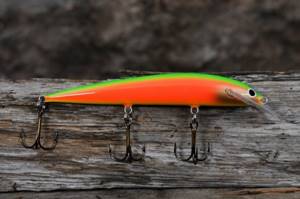
The design of a typical wobbler consists of the following components:
- Housings
- Blades
- Kryuchkov
- Loops for attaching fishing line
Frame
The body of the wobbler can be made of wood or plastic. To make wobblers from wood, they use: balsa, pine, hazel or oak. To make a wobbler from plastic, use: ABC plastic, polystyrene, polycarbonate or expanded polystyrene. Depending on the plastic used, the body of the wobbler can be either hollow inside or solidly cast.
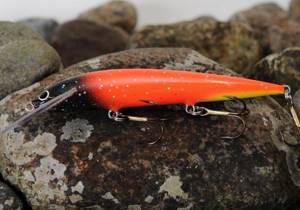
The wobbler body most often has the shape of a fish or other food items of predatory fish, such as frogs, crustaceans and insects.
The body of the wobbler should not only be similar in its shape and overall appearance to the live food of a predator, but also have such ballistic and aerohydrodynamic characteristics as to be both stable in water and have good flight qualities in the air.
The body of the wobbler can be either monolithic or consisting of several (two, three) parts. A wobbler consisting of several parts is more mobile in water; such wobblers are called compound wobblers.
To strengthen the body of the wobbler, a frame made of metal wire can be installed inside it, at one end of which there is a loop for tying fishing line, and at the other ends there are loops for attaching hooks.
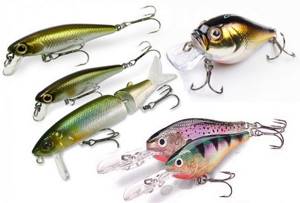
Noise chambers can be placed inside the wobbler body, inside which balls made of metal, glass or plastic can be placed. When the wobbler moves underwater, the balls move inside the noise chamber, creating an additional acoustic effect that attracts predators.
Inside the wobbler body there can also be a long-distance casting system, which has different names among different wobbler manufacturers. The long-distance casting system is a channel through which the weight moves. In the normal state, the weight is held by a magnet in the front part of the channel; when casting, the weight is detached from the magnet and shifted to the tail of the bait, thereby shifting the center of gravity of the wobbler, which increases the range and accuracy of the wobbler's flight. After the wobbler falls into the water, the weight is again fixed with a magnet in the front part of the channel, without interfering with the play of the wobbler.
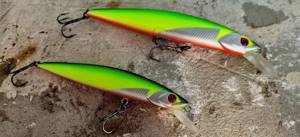
The body of the wobbler can be painted in the natural colors of the real prey of predators, or it can be painted in fantasy colors that provoke the predator to attack. Many wobblers have a holographic coating on the surface of the body, which increases the attractiveness of the bait to a predator.
Tungsten balls can act as a wobbler load. The weight creates the correct position of the wobbler in the water, provides the desired buoyancy, complements the play of the wobbler and gives it sound effects in the form of noise.
Wobbler blade
According to their design, all wobblers are divided into bladed and bladeless. Bladed wobblers have a special blade in their front part, which causes the wobbler to oscillate and go deep to a certain depth. Currently, the blades on most wobblers are made of transparent plastic, unnoticeable to predators, although there are models of particularly powerful wobblers on which metal blades are installed to increase strength.
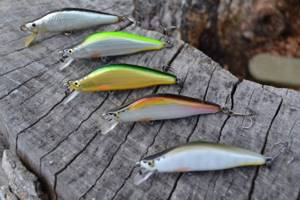
The wobbler blade has four main parameters:
- Length
- determines the depth at which the wobbler will work; the longer the blade, the deeper the wobbler works. A wobbler with a long blade can be thrown from side to side and even thrown to the surface, so the line loop for a wobbler with a long blade is placed in the middle of the blade, thereby increasing the stability of the bait. - Tilt
- determines the degree of intensity of the wobbler's play. The closer the inclination of the wobbler blade is to perpendicular, relative to the movement of the wobbler, the more intense the wobbler’s play will be. As the angle of inclination decreases, the intensity of the game decreases. - Area
also determines the intensity of the wobbler's play. Scientifically speaking, the intensity of the wobbler's play is determined by the projection of the area of the wobbler's blade perpendicular to the flow plane. As a rule, the wider the wobbler blade, the more intense its play. - Configuration
- determines the nuances of the behavior of the wobbler; often the blade is made slightly concave or with a slight depression.
Hook
Most wobblers are equipped with three-hook hooks and tees. The smallest wobblers have only one hook, medium-sized wobblers have two hooks, large wobblers are equipped with three hooks, the largest wobblers can sometimes be equipped with even four hooks.
You may be interested in: Spinnerbait
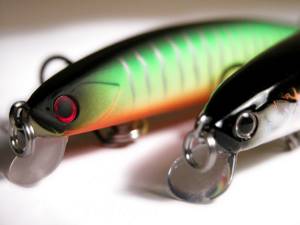
Some wobblers from individual manufacturers can be equipped with double hooks or single hooks. Wobblers designed for catching fish using the catch-and-release principle are equipped with single hooks without barbs, as they cause minimal damage to the fish.
On some wobblers, the hooks can be additionally decorated with feathers or synthetic materials, which, in some fishing conditions, increases the attractiveness of the bait for a predator.
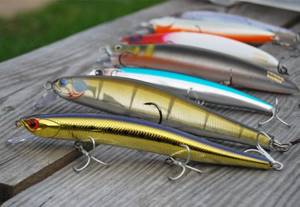
The total weight of the hooks installed on the wobbler affects the buoyancy of the wobbler; by installing lighter or heavier hooks on the wobbler, you can turn a floating wobbler into a sinking one and vice versa.
Fastening
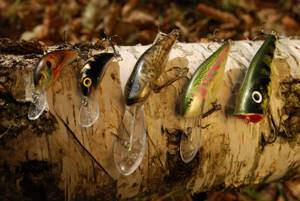
To attach the wobbler to the fishing line, the wobbler has a special wire loop, which can be located both in the bow of the bait and on the blade of the wobbler. The fishing line is attached to the wobbler's loop either through a carabiner with a swivel, or through a special loop knot. A carabiner with a swivel can influence the balancing of the wobbler and its play, and this influence is greater, the smaller the mass of the wobbler in relation to the mass of the carabiner with a swivel.
The history of the appearance of the wobbler. What is a wobbler
In the Russian fishing world, the word “ wobbler ” is understood as a bait with a three-dimensional structure, made of wood or plastic, of various shapes and sizes.
The purpose of the bait is to catch a predator by trolling or casting with spinning tackle.
The Russian word “wobbler” comes from the English verb “wobbler” - to swing, move, waddle, etc. “Overseas” fishermen, when using the word “wobbler,” mean spinners made of metal, also solid playing baits of a three-dimensional shape. So, when using the name “wobbler”, some representatives of the fishing process will mean different baits. So, if you want to be on the same wavelength with foreign fishermen, it is better to use the word “plug”.
The year in which the idea of creating a structure resembling a live fish was born is considered to be 1894, and the idea belongs to J. Haddon, who at that time was interested in breeding bees. Accidentally throwing wood shavings into the water, he noticed that its vibrations attracted fish. This moment served as the beginning of long thoughts and experiments on wood baits. Only at the beginning of the 20th century did he receive a patent for the bait - “fish-bait” - “Dowagiac” or literally translated “a lot of fish”.
Wobbler-spook (ghost) made of plastic was first made in 1932 by a family.
You can read a detailed description of the biography and activities of James Haddon here https://www.wikiwand.com/en/James_Haddon
Fin L. Rapala also left his mark on the history of wobblers. In 1936, he made this bait from pine, the appearance of which resembles a modern wobbler. It is also noteworthy that Rapala made a blade for the bait, which makes it sink to the desired depth; now the company of this inventive Finn is one of the largest producers of wobblers and other fishing equipment on the world market!
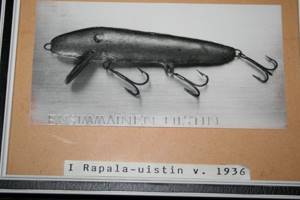
You can read about the history of the company, its latest products and achievements here https://rapala.fishing/our-history
Active “wobbler play” as a general property
The very word “crank” literally means something wobbling or wobbling - as, indeed, the word “wobbler” in general. The only difference is that the first name came to us from the English language, the second - after all, from German, and also extended to those baits that, to put it mildly, do not have much wobble and swaying. Therefore, we will still adhere to the English-language term - as it more accurately reflects the general essence of these baits.
It is also worth noting that not all wobblers with an active “game” are usually classified as cranks, but mainly those that have a “fat”, “shed” geometry or close to these two types. Many minnow-shaped wobblers are endowed with a very intense “game” of their own, but they are not considered cranks. This is neither bad nor good, but you just need to keep it in mind so that there are no discrepancies. Today we will talk about actively “playing” wobblers in general - regardless of their geometry.
Narrow minnows with small blades also “play” to some extent - they sway slightly when retrieved. Although this is quite ambiguous, let’s establish a somewhat qualitative line - we will consider those wobblers whose “game” is quite clearly transmitted along the cord and manifests itself in the form of pronounced vibration of the tip of the spinning rod.
How does a wobbler work?
The purpose of a wobbler is to provoke a predator to attack the bait.
Why does a predator “bite” on this bait:
- A wobbler imitates an object that a predatory fish hunts.
- An irritating moment of game and color, which makes the bait desirable.
- Protecting predators of your territory.
Based on this, the bait has the following design:

2.1 Wobbler body
The body is the main part of the bait structure, the appearance of which is designed to resemble a fish or other natural bait (for example, a crustacean). Some models have a two-piece body for greater mobility in the water.
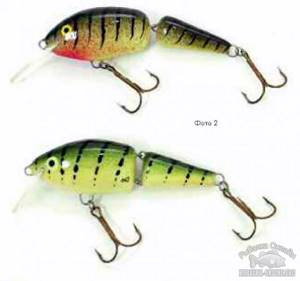
2.2 Wobbler blade
The blade is the working part of the bait, which sets the wobbler in motion (oscillation and penetration). This element is located in the area of the bait’s mouth.
Blade length, width and degree of inclination affect:
- gaming activity;
- dive speed;
- bait immersion depth.
Thus, a smaller angle of inclination between the horizontal axis and the blade allows you to achieve the highest speed of immersion in water to the desired depth. If the blade is installed in a perpendicular position relative to the axis, then the bait will not go deep.
Length determines the depth; the longer the blade, the deeper the dive. It also affects the behavior of the bait in the water. So, a wobbler with a long blade will be thrown to the sides or pushed to the surface by the counter resistance of the water. In such circumstances, we recommend balancing the bait by moving the loop of line to the middle part of the blade.
Area – affects the playing activity of the wobbler. The main thing is that the blade should be located perpendicular to the oncoming water, and if the water falls on the blade at an angle, the game decreases. The game does not depend on the entire area of the blade, but on the perpendicular component. Therefore, different areas do not affect the performance of the bait.
The blade configuration is the behavior of the bait. What matters here is how the blade meets the oncoming water. Based on this, the blade is designed concave or with a recess.
It should also be remembered that the width of the blade affects the intensity of the game. The wider, the more playful the wobbler, but also the more unstable; for this purpose, a bend step is provided on the wide blades.
2.3 Wobbler frame
The frame is a connecting element that has loops for fastening fishing hooks and fishing line.

2.4 How the wobbler works inside
Sectional view of the bait:

The front part of the wobbler is loaded with balls for balance, since there are hooks in the middle part and on the tail and the wobbler would roll backwards without loading. Acoustic wobblers additionally have rattle balls inside, which create certain noises in the water; they serve as the weighting element of the wobbler.
Some models have a “mass transfer” system. This is what it looks like
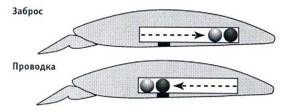
How to make a suspender from a wobbler
In order to turn an ordinary wobbler into a treasured suspender without spending money, you can apply a little imagination and knowledge of physics.
You will need:
- wobbler;
- syringe without needle;
- automatic drill (the smaller the better, preferably a manicure tool);
- cork from a water balloon or squeaky toy;
- bath with water.
The back of the wobbler is drilled along the width of the ball plug, filled with water using a syringe, the hole is closed with a plug, and the wobbler is immersed in the bath. Depending on the desired immersion speed of the wobbler, the amount of water in it is reduced or increased.
Also, a floating wobbler can be equipped with a weight , which is attached using epoxy resin. A too playful wobbler can be balanced in this way by placing the weight closer to the blade, and a slow one can be revived by moving the weight towards the center of gravity. The wobbler itself must be securely fixed.
For small wobblers, tungsten alloy beads are suitable as a load.
Of course, a homemade one will not be an analogue of the best suspenders, but it will bring its own results.
Pros and cons of a wobbler as an artificial bait for a predator
Pros:
- Suitable for strong currents.
- A wide range of colors and variety of shapes allows you to satisfy the needs of any predator.
- Game soundtrack.
- Duration of use.
Minuses:
- Not all models are designed for long-distance casting.
- Not all models are equipped with high-speed tempo.
- It is not a universal attachment, there is a limited range of fish for catching (for example, the wobbler successfully uses fish such as: sole, flathead, sea ruffe, sea dragon, dorado and other fish that live in the depths of the Mediterranean Sea, however, they will refuse the proposed attachment red mullet, pompano fish, etc.).
- Not suitable for use with all gear and types of fishing.
- High cost of bait.
Blade wobblers
Minnow
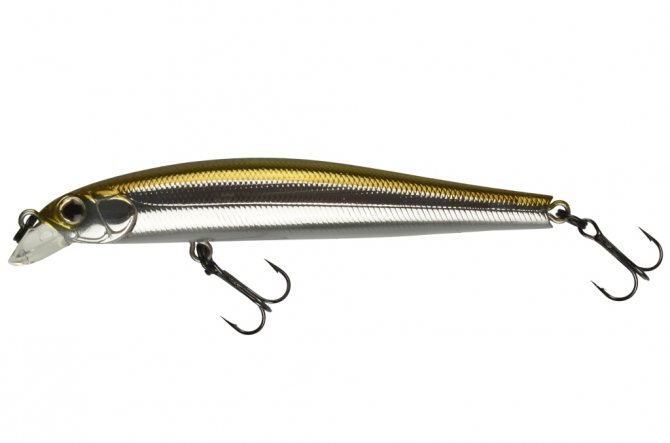
Minnows are wobblers of a purlin shape, with a convex back, the body of the wobbler smoothly tapers towards the tail. Minnow wobblers resemble the shape of a narrow-bodied fry.
with a convex back, an elongated and rounded body shape that tapers at the tail.
The blade is usually small, located at an average angle to the body of the wobbler. They have a rather weakly expressed game of their own. They are considered the most catchy wobblers for pike.
The name minnow wobblers comes from the word minnow, which translated from English means minnow fish. The minnow is a small fish similar to a minnow, reaching a weight of 100 grams and a length of 15 cm.
The popularity of minnow wobblers is explained by their good catchability and the ability for a spinner to experiment with different fishing patterns.
Minnows are produced with varying degrees of buoyancy and depth of penetration. Some of the most interesting minnow wobblers are suspenders, wobblers that have neutral buoyancy. Using a suspender, an angler can successfully fish all depths of a reservoir. An angler can independently make a suspended wobbler into a sinking or floating wobbler by placing heavier or lighter hooks on the wobbler.
Minnow wobblers with a length of 50 to 70 mm are best suited for catching perch. The best minnow size for catching pike is a wobbler with a length of 70 to 130 mm. For catching pike perch, a minnow with a length of 70 to 90 mm is suitable.
Fishing with a minnow wobbler requires the angler to have good skills in handling a spinning rod and good command of various fishing techniques.
The minnow wobbler, thanks to the presence of a blade, has its own game and can work with uniform wiring. But the full potential of the minnow is revealed when using jerk wiring, the so-called twitching. When jerking, it is very important to observe pauses, since most attacks by predators occur precisely during them. The jerk attracts the predator's attention to the bait, and the pause gives him the opportunity to catch up with the bait and attack it.
Shad
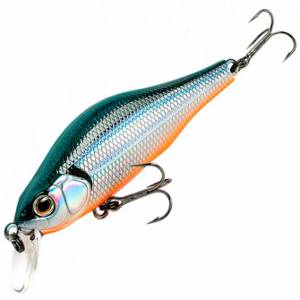
Shad wobblers have a laterally flattened, high body. The name of the wobbler comes from the English word shad, which means a fish that resembles a herring. The shape of the wobbler's body really resembles a sled or roach.
Shad wobblers can be either floating or sinking, both designed for fishing in shallow water and for fishing in deep water.
Shad wobblers are primarily designed for catching perch; pike and pike perch, as a rule, are much worse caught with them. Therefore, it makes no sense to buy a large shad wobbler. The optimal size of a shad wobbler is a wobbler with a length of 40 to 70 mm.
Shad wobblers do not have their own bright game, so they require the angler to master different fishing techniques. Due to the flat shape of shad wobbler baits, they do not have the best flight qualities, so it makes sense to choose wobblers equipped with a long-distance casting system. Due to the shape of the bait, shad have high water resistance when retrieving, so to fish with this wobbler, you need to choose the right spinning rod.

Shad behaves well in the current, holds the stream well when other wobblers, under the same conditions, are thrown to the surface. In still water, shad work on any type of retrieve: both uniform and stop-and-go and twitching.
Shad wobblers are a specific type of wobbler and it is not recommended for a novice spinning angler to purchase them, because for them there are more interesting types of wobblers that make sense to master first.
Crank
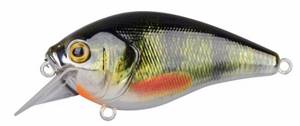
The crank wobbler has a wide, convex, laterally flattened oval body that resembles a drop. Crank is a transitional form between shad and fat wobblers; in its appearance it is somewhat reminiscent of crucian carp. The name crank comes from the English word crank, which means swinging. Crank has his own active game.
Initially developed abroad for catching bass and trout, in our conditions it catches well perch, trout and chub, due to the high-frequency vibrations created by the wobbler.
Crank wobblers can be either floating or sinking, both designed for fishing in shallow water and for fishing in deep water. Cranks work great both in still water and in currents. The cranks, even when working in the current and at high speeds, do not lose their play, while creating high-frequency vibrations that attract predators. With even wiring, the crank, with its rattling, imitates the convulsions of a wounded fish.
Cranks have good flight qualities due to their compact size and fairly heavy weight. Most crank wobblers have lengths from 50 to 80 mm and weight up to 10 grams.
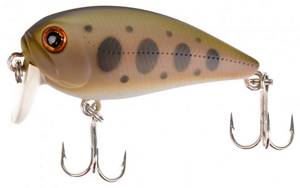
Many cranks have noise chambers in their design, with balls located in them, which create an additional acoustic effect when guiding the wobbler. For fishing in cloudy weather conditions and when fishing in muddy water, cranks of bright, acidic colors show good results.
Floating cranks are often used for drift fishing; for this, after casting a wobbler, it is given the opportunity to float downstream to the place of interest to the angler, then the reel bail closes and the angler begins reeling in the fishing line. This fishing method is convenient for catching shy fish (trout, chub), and can also be used in places where the shore does not allow regular bait casting.
You may be interested in: Asp
Thanks to the presence of their own game, crank wobblers are easily mastered by beginning spinners.
Fat
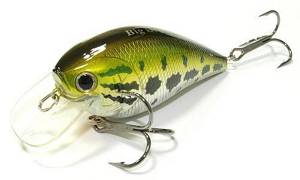
The fat wobbler has an inflated, drop-shaped body. The name fat comes from the English word fat, which means thick, fat.
Fat wobblers, due to their round shape, have good flight qualities. Typically, fats are produced with a small, fairly wide blade and have a depth of no more than 1.5 meters. Fat wobblers have their own active game, which is reminiscent of a heavyweight waddling from side to side. The action of the fat wobbler is high-frequency with a wide amplitude.
Many fats have noise chambers inside their body, with balls located in them, which create an acoustic effect when guiding the wobbler, which attracts the attention of a predator.
Fats work well on the most common uniform wiring. When fishing with them, you can also use all kinds of pauses, jerks and pulls, thereby introducing variety into the behavior of the wobbler.
Fat wobblers are the main bait for catching chub; they cope well with catching trout, ide, and perch.
Fats are used when catching active predators or fish that feed in the upper layers of water. Fats can also be used for fishing in the surface layer of a reservoir, when underwater vegetation prevents the use of deeper-reaching baits.
Fat wobblers are well suited for beginner spinning anglers, as they do not require mastery of complex techniques for retrieving the bait.
Classification of wobblers
Wobblers are presented in a wide variety of variations, so it is difficult for a novice fisherman to make a choice regarding a specific bait.
1 By shape
4.1.1 With blades
Wobbler minnow or minnow - translated as “fry”. A long, not wide wobbler, used mainly on the surface of the water. The most popular bait for spinning fishing. It has its own unique elongated shape, which distinguishes it from other types of wobblers. The design of the bait includes 2-3 tees. Minnows can be floating, sinking or suspending.
Types of minnows. Classic - with a convex back, an elongated and rounded body shape, which tapers at the tail. The model is equipped with a blade.
Deep-sea - the design provides a large blade and a blade of varying lengths, which affects the depth of the bait. The length of the blade part creates resistance during jerking movements during wiring. When purchasing such a wobbler from a seller, you need to clarify the speed at which the bait rises to the surface, since knowing this indicator you can easily calculate the immersion depth of the wobbler.
Composite minnows have an advantage in their game, they are flexible and perfectly imitate the behavior of a wounded individual.
Mini-minnow - this model is available in two versions: “lite” (length up to 5 cm) and “ultra lite”. Ideal for fishing on small rivers.
Shad or shad shad is voluminous in shape and resembles a herring. It is used for casting and deep-water fishing. The downside is a large load on the tackle due to water resistance due to the wide blade.
Fat or fat (thick) has the shape of a drop. Area of application: shallow water. Pros: high-frequency play with wide amplitude. Disadvantages: the shape of the bait gives strong resistance in the water, which loads the gear.
Crank or crank (swinging). Feature: active play with even wiring. In terms of its behavior in water, the crank is similar to a wounded (sick) fish, which attracts predatory fish. Pros: good range, creates noise when retrieving, can attract inactive fish, easy to use for beginner spinners.
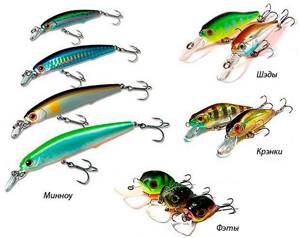
4.1.2 Surface wobblers
Popper or popper - has an original appearance, imitating a feeding fish with an open stigma and a peculiar gurgling sound, which is the main difference from other models. Does not have a blade. Scope of application: the surface of an open or algal area of water (lake, pond, etc.). Wiring method: twitching, jerking. The main thing is jerky wiring with the creation of a characteristic sound accompaniment.
Stikbait (flasher, jumper) stik beit is a bladeless bait designed for fishing in the upper layers of water (it glides along the water surface, leaving behind a long trail of bubbles). Suitable for fishing in weedy waters and windy conditions. The peculiarity of the bait: it sinks when at rest, the wiring depends on the fisherman, it is long-range, it has a sound accompaniment.

Crawler or crawler - moves in the water, swaying with a specific “slurping” sound. Scope of application: reservoirs with quiet (stagnant) water, overgrown with vegetation. The ideal depth for fishing is no more than 1.5 m.

4.1.3 Wobblers without blades with medium diving depth
Jerk bait or jerk bait (pull) is a flattened, heavy and large wobbler that, when retrieved, resembles a wounded fish. The wiring method is jerk. Scope of application: shallow and deep water areas. Disadvantage - requires skill to use.
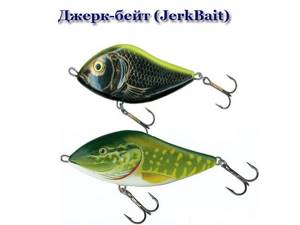
Rattlin or rattlin is a flattened, sinking wobbler without a blade. It has several names: lipless crankbaits, vibration (vib). In water it creates a characteristic vibrating sound. A distinctive feature is that the loop for the fishing line is located in the middle part of the wobbler’s body and there are 2 tees. It is used when fishing in deep-sea (bottom) areas of active predators.
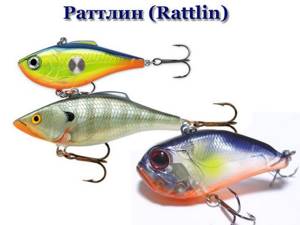
Darter is a narrow, long wobbler, characterized by low-frequency play and good dynamics in the water. Simulates a feeding fish.
4.1.4 Composers
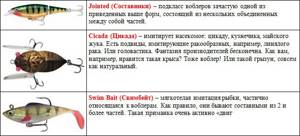
Watch a short video review of wobblers by shape
Story
The first prototype of the future modern wobbler was created in 1894 by the American beekeeper James Haddon. One day, Haddon was whittling boards for his apiary on the shore of the lake and threw the shavings into the water. Just as he was about to leave for home, he noticed that American largemouth bass (bass) were greedily grabbing wood shavings floating with the current.
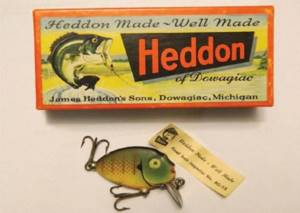
The first wobbler created by Haddon resembled a frog in appearance. After this incident, Haddon experimented with making various wooden fishing lures for 8 years, and in 1902 he received a patent for a new fishing lure called the Slopenose Dowagiac Expert.
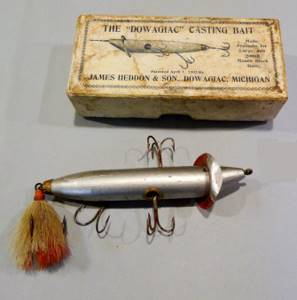
Also in 1902, James Heddon and Son, Co. was founded. Which began to produce fishing lures. The Dowagiac Expert wobbler and subsequent wobblers produced by Haddon enjoyed great commercial success. In 1932, James Heddon and Son, Co. The world's first plastic wobbler was manufactured, called Spook, which translates as a ghost, so named because of its transparent body.
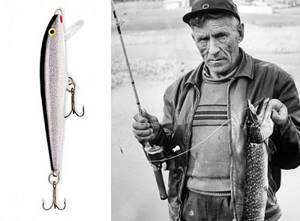
Finnish fisherman Lauri Rapala played a major role in creating the modern type of wobbler. In 1936, he made his first wobbler, which is still produced today under the name Rapala Original Floater. Lauri Rapala's merit lies in the fact that he was the first in the world to make a wobbler with a blade, which makes the wobbler oscillate and go to a certain depth. The Rapala company, created by Lauri Rapala, is today one of the largest manufacturers of fishing lures in the world.
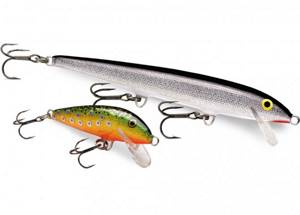
Over time, more and more wobbler manufacturers began to make their lures from plastic rather than wood. But wobblers made of wood have not ceased to exist; they are still produced and still occupy their well-deserved places in the boxes of spinners.
Buoyancy classification
5.1 Floating wobblers
Another name is “superficial” or in English. "shallow runner"
Peculiarity:
- in a state of calm in the water, it will not sink to the bottom, but will remain on the surface;
- when reeling in the fishing line it dives;
- when you stop pulling the fishing line, it floats up;
- forgives mistakes when casting;
- allow the use of a wobbler downstream;
- With such a wobbler, when retrieving, you can “jump over” obstacles encountered underwater (stop reeling in the fishing line, the wobbler will float up).
Floating wobblers are divided into:
- Smoothly diving. They have a voluminous, pear-shaped, broad-bladed shape. The fishing line is attached to a blade, which allows the wobbler to dive at the beginning of reeling in the fishing line and dive into the water during slow retrieval.
Adviсe:
- apply at a depth of up to 2 m;
- do fast wiring, but do not rush;
- a wobbler 3–7 cm long does not require additional balancing due to its stability on the water surface;
- models 15 cm or more can be used at depths of up to 4.5 m, but at low currents.
- Sharply diving (deep runner) - oblong in shape and with a small blade, the angle of which is from 60 to 90 degrees. A bait with a large angle and a decent line reeling speed allows the wobbler to quickly dive to a depth of 6 m.
- they play great when retrieved slowly;
- with a small current or a depth of 4 to 5 m, they play monotonously, which makes them not interesting for fish.
Peculiarity:
5.2 Fast pop-up wobblers
The peculiarity of the model is that it does not sink to the bottom in a calm position, it sinks only when retrieving. In order for the wobbler to sink to the required depth, you need to increase the wiring speed.
5.3 Slow pop-ups
A feature of wobblers is that if there is a pause during wiring, they slowly return to their original position (surface).
5.4 Sinking, fast-sinking and slow-sinking wobblers
The advantage of “sinking” wobblers:
- good range, which allows you to cover and fish a wide area of the reservoir when casting;
- Some models of “sinking” wobblers are good for fishing in still water, and some against the current (Magnum CD/RAPALA, Countdown/RAPALA;
- compact in size;
- heavy in weight;
- excellent flight properties.
To test a wobbler for its ability to sink, you need to throw it into the water and if it goes down, then the bait is a type of sinking wobbler.
Application area:
- fishing at long distances, due to the manufacturer’s built-in system for such casting;
- fishing in fast currents.
A detailed review of “sinking” wobblers was made by professional fisherman V. Andreev in the book “Spoons and Wobblers for Spinning” https://clck.ru/CdgNx
5.5 Useful video
A short video review of the degree of buoyancy of wobblers (TK Aktiv)
Experts from the Russian magazine “Fishing in Rus'” A. Vyunov and A. Chernushenko talk in detail about the types, types and use of surface baits
How to catch pike with a wobbler
The key to successful fishing of this type is not only the correct choice of gear, but also a good knowledge of the characteristics and capabilities of your lures. Despite the huge number of models, wobblers can be classified according to several general characteristics.
By immersion depth:
- superficial;
- subsurface;
- deep-sea.
By buoyancy:
- floating
- drowning
- suspenders (according to the manufacturer’s plan, such baits should hold quietly and hang in the water column)
Finally, according to design, wobblers are divided into bladed (minnow, shad, fad, crankbait, crawler) and bladeless (poppers, stickbaits, rattlins, propbaits, jerkbaits, walkers).
For confident fishing, it is enough to have 5-7 wobblers for different occasions. For example, minnows imitate fry as realistically as possible and are excellent for summer fishing, and in the fall it is better to use cranks, especially in rivers and reservoirs.
The optimal wobbler size for pike fishing is 7-12 cm.
You will also need a certain rod - a fast-action spinning rod with a fairly rigid, well-responsive tip and a reliable butt. For fishing from the shore, a rod 2.4 m long is sufficient.
More information about fishing for pike using spinning wobblers in the video:
Wobbler deepening
This is the distance to which a wobbler can submerge under water.
Kinds:
- submersible up to half a meter (they have a small blade or are not equipped with one);
- up to 1 m (shallow submersible);
- up to average value - 1.5 m;
- deep-sea – 2.5 m;
- up to 3 m – medium-deep water;
- 12 m – super deep water.

The difference between deep-sea baits and surface ones is the presence of a wide blade that is not deviated from the axis of the fishing line.
6.1 Fishing technique and wiring with buried wobblers
You will find a detailed description of wiring lubed wobblers from professional V. Andreev here https://clck.ru/CdgQw
The nuances of suspender wiring
The basic technique for wiring this wobbler is twitching, i.e. jerk wiring. But, some points are a little different. Since the suspender hangs on pauses, they need to be more emphasized. If, when inserting a regular minnow wobbler, a pause of 1-3 seconds is the norm, then with a suspender the pause value can and even should be increased to 4-8 seconds. Especially if the activity of the pike is low and it refuses to take on a fast retrieve.
So, when going fishing, you should definitely put several models of suspender wobblers in the box. If the predator is passive, then it is likely that a wobbler hovering during pauses will help you get away from zero and still catch a fish.
What are suspenders
Suspender literally means “suspend”. A complex model of wobblers, the peculiarity of which is that when there is a pause (stop) in the wiring, it does not immediately float up, that is, it behaves like a floating model of a wobbler, but it does not sink, but remains in a neutral position.
The downside of a suspender is its slowness when retrieving, which is bad when catching an active predator. Plus - an excellent bait for lazy fish!
How is it arranged? The wobbler is equipped with a neutral buoyancy system (balancing). The body is made of plastic, a hollow chamber and balls, which help when casting the wobbler and ensure its balancing.
Outwardly it resembles a wobbler - a minnow.
To test a wobbler at home, just immerse it on a leash in a container of water and if it “hangs” in one state for a while, then it is a suspender.
Suspenders are:
- suspending or SP – neutrally buoyant model;
- super Slow Sinking or (SSS) – after a pause in the retrieve they slowly begin to sink.
Advice: when purchasing the right suspender, depending on the fishing conditions and gear, you need to pay attention to the packaging, where the manufacturer indicates the conditions under which the bait can hang in the water.
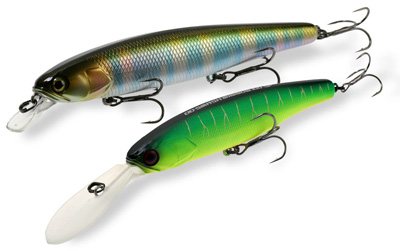
7.1 Fishing technique and fishing with suspenders
The first stage is to involve the wobbler in the game:
- rapid rotation of an inertia-free or multiplier reel;
- rod movement;
- trolling;
- jerking.
The best way is to use the rotation of the reel, since after twitching and pulling the wobbler stops and the fishing line weakens, so the ability to catch a bite is lost, and the reel makes the fishing line ready. In this case, the tackle must be in working position. If the suspender is brought into play only by the tackle, then at that moment it is not ready to accept a bite and the fish will leave.
The second stage is speed. If the fish is active, then the pauses are short and vice versa.
Advice: use braid, as the lack of stretch will allow you to clearly feel the bite and make a sharp hook.
The figure shows the wiring diagram of several types of suspenders
You can observe the behavior of the wobbler when wiring the suspender in this video (from 4river)
Types of wobblers and their markings
Wobbler is a bait made of hard material, which is designed for catching predatory species using a spinning rod. Wood, cork, plastic, and polymers are used in its production. It comes in the form of a small fish, a frog, or a newt. There are forms resembling insects and crustaceans. Depending on the fishing conditions, there are several hundred types of gear.
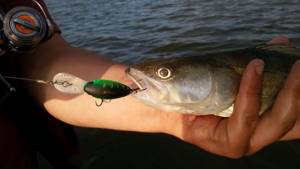
Fishing with a wobbler
The bait has several parts:
- body – monolithic or consisting of several parts;
- blade - a special element located in the front part of the bait;
- hooks - double type or tees.
The main features, in addition to the external shape, by which one can distinguish the type of wobbler are buoyancy and immersion depth. The size, color and material of each type of bait may be different.
Buoyancy
This feature characterizes the behavior of a wobbler on water. There are different types of bait:
- floating - wobblers that always remain on the surface of the water and do not sink;
- sinking - baits that sink to the bottom under the weight of their own weight;
- neutral (another name is suspenders) - immersed up to 20 cm in water without additional weighting.
An international classification has been developed for each type of buoyancy. Marking of floating wobblers:
- SF – after casting, the bait slowly floats to the surface of the water and remains on it;
- F – the wobbler floats and does not submerge;
- FF – the bait floats up quickly.
For sinking wobblers the following designations are accepted:
- S – bait sinking to the bottom;
- FS – fast sinking;
- SS – the bait slowly sinks to the bottom.
Wobblers with neutral buoyancy are marked:
- SU, SP – the bait is constantly located at a depth of about 20 cm from the surface of the water;
- SSS – the wobbler sinks very slowly from a neutral position to the bottom.
Wobblers also vary in the depth to which they dive.
Immersion depth
There are three types:
- The bait does not sink more than 1 meter. Among these wobblers, the most famous are chaggers and gliders.
- The wobbler can go to a depth of over 10 meters. They are designated DR.
- Gear operating at medium depths - MDR.
For branded bait models, the immersion depth indicator is indicated on the body. Deep-sea wobblers can be distinguished by their massive blade, which has a slight angle of inclination to the base.
Case shape
The shape of the wobbler body can be elongated, spherical, or teardrop-shaped. These varieties allow you to imitate the behavior of the most common prey for predators - fry or small fish:
- Minnow. Thin and elongated body. The shape of the bait resembles a minnow or bleak.
- Crank. The body is flattened from the sides.
- Shed. Shape resembling a small herring.
- Fat. Shortened teardrop-shaped body.
- Popper. A bait that has a recess at the base that imitates the open mouth of a fish. When retrieving, noise and splashes are created, which make the wobbler play similar to the real behavior of the prey of a predatory fish.
- Crowler. This species has two lobes at the base. When retrieving, the bait deviates to the left and right.
Some models have small propellers installed instead of blades. This device may be located at the base or tail of the housing. Sometimes they are made in both parts. These wobblers are called proppers.

A separate type - baits consisting of several connected parts. Another variety is wobblers that completely imitate the shape of frogs, crustaceans, shrimp, and large aquatic insects.
Wobbler wiring technique
10.1 Uniform wiring Most effective in strong currents.
10.2 Aggressive wiring
10.3 Twitching
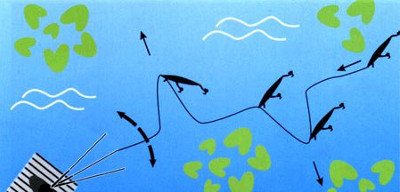
10.4 Ripping Ripping is a synonym for the words “twitching” and “derking”. The peculiarity of this technique is vigorous pulling of the short tackle down and up, with long pauses, which serve as time to wind the slack line onto the reel.
10.5 Jerking Suitable for using heavy deep-sea baits. A detailed article about what jerking is and how to use this spinning fishing technique.
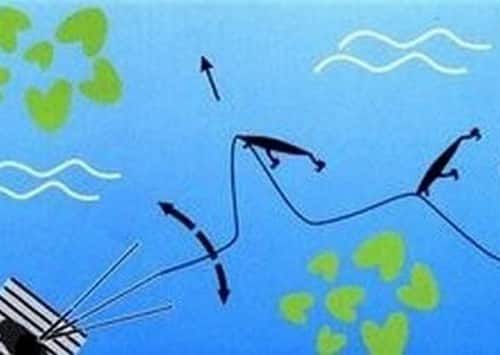
10.6 Stop and go wiring The stop and go wiring diagram looks like this

Fishing with suspenders: the main thing is to pause
However, between suspender and suspender! We already know that there are active, normal and passive baits (Fig. 5).
I usually start fishing with a normal model. It starts working quite quickly, within 2-3 turns of the coil it manages to make several oscillations and then gradually stops. The usual pause duration for such a bait is 0.5-1 s, then the cycle is repeated. It makes no sense to take a longer pause, since, according to my observations, the predator in such cases almost always immediately takes after the bait.
Apparently, stopping the suspender gives the predator a signal to attack, and the beginning of the bait’s movement warns: “the prey can escape!” — the attack begins, and at the moment of slowing down and stopping, the wobbler grabs. And although the vast majority of fish caught in this way were caught on the back tee, it is possible that some of them attacked from other positions, but got away. After all, in an intermittent movement mode, it is difficult for a predator to calculate the trajectory of an attack - a moving target must be attacked proactively, but what if it suddenly starts to stop? Miss? Maybe that’s why there are more than enough catches when fishing with a suspender. And this is another drawback.
But if the duration of the pause when moving a “normal” suspender remains practically unchanged - 0.5-1.0 s, then the duration of the progressive “steps” can change at our discretion. If we want to quickly fish a working area where the fish are quite active, we can make 5-10 revolutions of the reel between pauses; if the predator is lazy, the number of revolutions is reduced to 2-3.
To be fair, it is worth saying that it is not always worthwhile to unnecessarily increase the duration of the progressive “steps” of the suspender. After all, these wobblers are designed specifically for wiring in the “jerk-stop” mode, which means that all their elements, including acoustic ones, are designed to work in this mode. And if the built-in rattle makes a sound that attracts fish with a short jerk, then with a long straight movement the sound may change, and not for the better. This is probably why fish don’t like some models of suspenders with even wiring, although they seem to play well outwardly. And if you switch to jerk wiring, you’ll immediately get a bite!
But it often happens that a cautious fish, although it revolves around a “normal” suspender, does not want to take it either. How can you try to outsmart her?
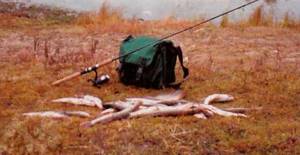
Photo 6. A spinner's catch using suspenders.
The first method is wiring at a minimum pace of “1 revolution of the coil - pause.” But to do this, you need to take an active suspender model, which in 1 revolution will have time to “start up” and make 1-2 oscillations, which is beyond the power of a conventional model. And it is advisable to increase the pause to 1-2 s. JAXON Slim worked fine for me in this mode. Other models may have their own nuances, although the general rules will apply to them (see Fig. 5).
With an active suspender, the disadvantages of this type of bait are even more pronounced: the minimum speed of wiring and a large number of gatherings. However, the main advantage overshadows everything: the slowest retrieve with stops can tempt even the laziest or cautious fish, which does not take anything else. Worth a try!
